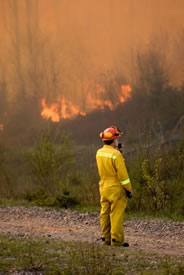Forest Fire Fighter Jobs – Issues for Firefighters
Wildland fires are dangerous beasts. Every year, they consume trees, wildlife and people, and as a wildland firefighter you will be the only line of defense between a raging fire and the life the National Forest Service is sworn to protect.

Fire crews travel from place to place during a typical six month assignment, and crew members are required to be on call twenty-four hours per day, seven days a week. They are away from friends and family for weeks at a time, and during a fire event, ground crews often have to pack in all their water and supplies. The nature of firefighting makes this job inherently hazardous and demanding. Before applying for a position as a wildland firefighter, consider some of the risks and issues you’ll be taking on.
FACT! Clear cutting practices mimic the clearing out of undesirable vegetation that happens when a natural wildfire occurs.
Risks in the Field
Many National Forest Service lands are remote and difficult to traverse. Working on fire suppression in these primitive, backcountry conditions is arduous, and takes immense stamina and discipline. Many firefighting crews must remain self-sufficient within the fire line for days at a time, as supplies, tools, and food and water are dropped in by parachute. This is why firefighters are required to undergo rigorous physical training and testing before qualifying to work on a fire suppression crew.
Fighting on the line, you’ll be subjected to intense heat and dry winds. Wildland firefighters commonly contend with heat exhaustion, heat stroke, and sunburn, as well as smoke congestion and irritation to eyes, nose, throat and lungs. Besides digging and setting up fire control lines, firefighters often have to cut open smoldering trees to subdue any lingering flames or sparks, using water dropped by helicopters. When water is not available, firefighters have to remove burning limbs and coals from the hotspot manually, and then cover them with dirt to put out the fire.
Over the course of a wildland fire event, you may hike countless miles carrying a 60-100 pound pack, and if you’re a smokejumper, you’ll do so after having parachuted out of an airplane. The risks are many, and firefighting is not for the faint of heart.
FACT! Wildfires can move at up to fourteen miles an hour, consuming everything in their path at an alarming rate.
Issues to Consider
Because of the enormous demands that wildland firefighting places upon both body and mind, you will need to be at an optimum health and pass a rigorous annual physical test before qualifying to work on the fire line. The Work Capacity Test entails completing a three mile hike carrying a 45 pound pack within a specified time limit.
As a wildland firefighter, your day-to-day schedule will be unusual. This is no Monday to Friday, nine to five job. Instead, you’ll likely be working twelve, eighteen, or even twenty-four shifts during a fire event. You may not be able to take breaks, shower or even get a full night’s sleep. And you’ll be sleeping on the ground. On the flip-side, you’ll be making both hazard pay and overtime pay during these events.
Due to the somewhat seasonal nature of wildland fires, the majority of firefighting positions are short-term. Although the National Forest Service fire suppression work force reaches its peak numbers during the summer, there are different types of short-term schedules to choose from. Some people work for a limited number of hours during the summer months. Others choose to work a semi-permanent schedule, alternating with twenty-six weeks on and twenty-six weeks off on a permanent basis. Some work full-time, year round, but have limited assignments lasting between one and four years.
There is also a contingent of permanent, full-time workers who have made their careers in the Forest Service Fire and Aviation Management program. If you want to sign on as a seasonal firefighter, keep in mind that applications are due in January- before the official fire season begins.
Quick Summary:
- Wildland firefighters commonly contend with heat exhaustion, heat stroke and sunburn, as well as smoke congestion and irritation to eyes, nose, throat, and lungs.
- Conditions in the backcountry are primitive and demanding, and firefighters must be able to remain self sufficient for days at a time. Their food, water and supplies are periodically dropped in by parachute.
- Fire management techniques and programs are constantly evolving, and firefighters and fire management personnel are required to attend continuing education courses to stay up to date in the field.
- You will likely work twelve, eighteen, or even twenty-four hour shifts during a wildland fire event.


 Teach English in Asia
Teach English in Asia  Cruise Ship Jobs
Cruise Ship Jobs  Alaska Fishing Industry Jobs
Alaska Fishing Industry Jobs  Sharing Economy / Gig Economy
Sharing Economy / Gig Economy